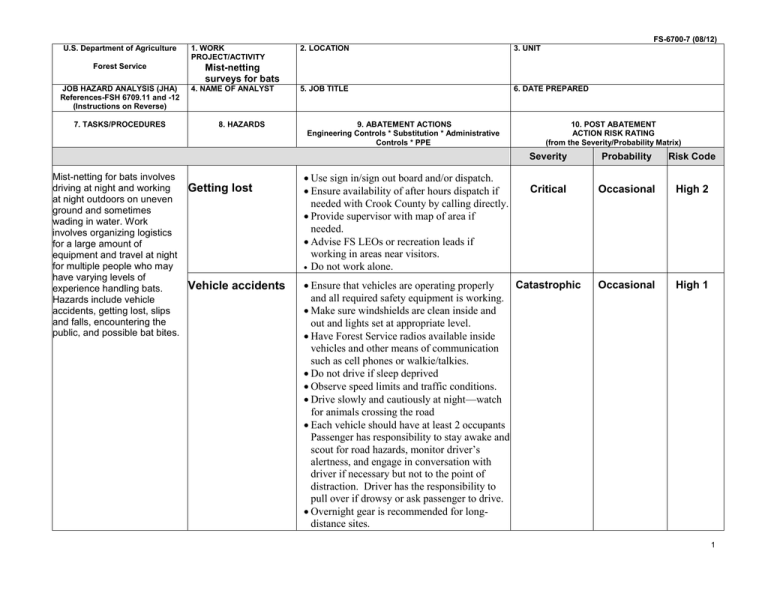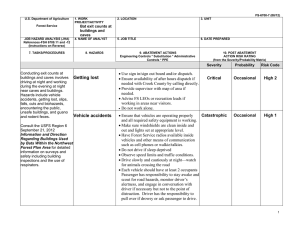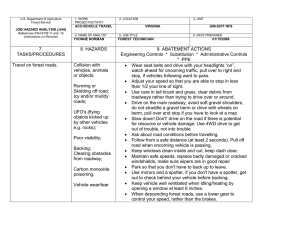Document 10555582
advertisement

FS-6700-7 (08/12) U.S. Department of Agriculture Forest Service JOB HAZARD ANALYSIS (JHA) References-FSH 6709.11 and -12 (Instructions on Reverse) 7. TASKS/PROCEDURES Mist-netting for bats involves driving at night and working at night outdoors on uneven ground and sometimes wading in water. Work involves organizing logistics for a large amount of equipment and travel at night for multiple people who may have varying levels of experience handling bats. Hazards include vehicle accidents, getting lost, slips and falls, encountering the public, and possible bat bites. 1. WORK PROJECT/ACTIVITY 2. LOCATION 3. UNIT 5. JOB TITLE 6. DATE PREPARED Mist-netting surveys for bats 4. NAME OF ANALYST 8. HAZARDS Getting lost Vehicle accidents 9. ABATEMENT ACTIONS Engineering Controls * Substitution * Administrative Controls * PPE Use sign in/sign out board and/or dispatch. Ensure availability of after hours dispatch if needed with Crook County by calling directly. Provide supervisor with map of area if needed. Advise FS LEOs or recreation leads if working in areas near visitors. Do not work alone. 10. POST ABATEMENT ACTION RISK RATING (from the Severity/Probability Matrix) Severity Probability Risk Code Critical Occasional High 2 Occasional High 1 Catastrophic Ensure that vehicles are operating properly and all required safety equipment is working. Make sure windshields are clean inside and out and lights set at appropriate level. Have Forest Service radios available inside vehicles and other means of communication such as cell phones or walkie/talkies. Do not drive if sleep deprived Observe speed limits and traffic conditions. Drive slowly and cautiously at night—watch for animals crossing the road Each vehicle should have at least 2 occupants Passenger has responsibility to stay awake and scout for road hazards, monitor driver’s alertness, and engage in conversation with driver if necessary but not to the point of distraction. Driver has the responsibility to pull over if drowsy or ask passenger to drive. Overnight gear is recommended for longdistance sites. 1 Caravanning Slips and falls If caravanning, all vehicles must stay together. Each vehicle must have a map of location with appropriate contact information of other persons in vehicles written on the map. The lead vehicle is responsible for tracking all vehicles behind them. If lead vehicle loses sight of any rig behind them, they should pull over and wait and contact the rig by radio/cell phone/walkie/talkie if they are not visible within 5 minutes. If vehicle is not visible and contact is not made, lead vehicle should return to look for lost vehicle. Cell phone use by the driver including handsfree is not allowed while driving a Forest Service vehicle. Scout site during day if unfamiliar to evaluate potential hazards, identify safest routes, and place flagging if needed. Notify all bat handlers and assistants before going to site that work may occur at cave entrances (but not inside). Wear sturdy hiking boots that cover ankles (minimum 6 inch height when measured from bottom of heel) and waders/wading boots with non-skid soles for work in water. Use of coveralls to comply with WNS decontamination protocol may be baggy and unfamiliar—work slowly to avoid tripping. Wear long-sleeved shirts and pants and layered clothing for cool nights. Do not hurry when working. Travel together and do not outpace slowest person. Cease mist-netting if bat numbers are too high for the number or experience of handlers. Have at least 2 headlamps with strong white lights. Do not use weak batteries—carry plenty of extra batteries and change often. Avoid shining lights into co-workers’ eyes. Take plenty of water and food for a long day and evening. Rest if needed. Critical Ocassional High 2 Critical Ocassional High 2 2 Poisonous insects/snakes Persons of questionable intent Disease transmission to humans Always look first before placing hands in Catastrophic rocks, crevices, or brushy areas When using an acoustic detector with head phones, watch where you are walking. Avoid walking in to brushy areas that might provide cover for poisonous snakes without first listening and looking for them. Always work on public land unless prior Critical explicit approval has been given to conduct surveys on private land, preferably in writing. If surveying popular sites contact Forest Service recreation leads, and/or LEOs let them know you will be working at night Answer questions about survey work in the field but do not allow people to participate or be near the mist-nets or processing station. Trust your instincts on motivation for individuals—call dispatch, other co-workers, and/or return to your vehicle if you feel unsafe at all. Equipment can be left at the site—if there is time to tie up (not take down) mist nets, do so, but not if situation is imminently dangerous. Leave area if needed. Although rabies is present in bat colonies at Catastrophic low levels, it can be transmitted from a rabid bat to a human through a bite and potentially from direct contact of infected bat saliva into the eyes, mouth, or nose. Only employees/volunteers with pre-exposure rabies vaccinations and protective titers and current tetanus shots are allowed to handle live, injured or dead bats, bats in bags, or conduct wing tissue biopsy. If accidental ungloved contact or a bat bite occurs, wash area with soap and water. If there is a suspected exposure to rabies, consult with supervisor, collect the bat if possible (only by someone who has received pre-exposure rabies vaccinations and protective titers and current tetanus shots), and follow the Remote High 2 Ocassional High 2 Unlikely Medium 3 3 Disease transmission and stress to bats 11. LINE OFFICER SIGNATURE Algorithm for prevention of rabies after animal bites in Oregon State of Oregon procedures for potential rabies exposure http://public.health.oregon.gov/DiseasesConditi ons/DiseasesAZ/Pages/disease.aspx?did=41 Wear protective gloves on both hands to avoid being bitten. Wear latex gloves over the protective gloves and change between each bat handling to protect bats. Do not touch face with gloves that have handled bats. Wash hands frequently during the night with soap and water. To avoid spreading of white-nose syndrome Catastrophic (WNS) between caves, equipment, clothing, and boots should be cleaned according to most recent recommended protocols https://www.whitenosesyndrome.org/topics/de contamination If skin samples or bats need to be collected for WNS submission, follow latest USGS National Wildlife Health Center recommendations. Ensure proper training for handling bats in mist nets and while collecting data to minimize stress to bats and minimize potential bites. Monitor bats in mist-net continually—do not allow bats to become too entangled. Release bats away from nets but in the general area. Do not release bats near non-vaccinated assistants. Observe proper decontamination procedures for cleaning equipment, boots, and clothing to avoid/minimize spread of Batrachochytrium dendrobatidis to amphibians. Decon protocol for WNS will suffice for Chytrid fungus. 12. TITLE Unlikely Medium 3 13. DATE District Ranger 4 JHA Instructions (References-FSH 6709.11 and .12) The JHA shall identify the location of the work project or activity, the name of employee(s) involved in the process, the date(s) of acknowledgment, and the name of the appropriate line officer approving the JHA. The line officer acknowledges that employees have read and understand the contents, have received the required training, and are qualified to perform the work project or activity. Blocks 1, 2, 3, 4, 5, and 6: Self-explanatory. Block 7: Identify all tasks and procedures associated with the work project or activity that have potential to cause injury or illness to personnel and damage to property or material. Include emergency evacuation procedures (EEP). Block 8: Identify all known or suspect hazards associated with each respective task/procedure listed in block 7. For example: a. Research past accidents/incidents. b. Research the Health and Safety Code, FSH 6709.11 or other appropriate literature. c. Discuss the work project/activity with participants. d. Observe the work project/activity. Emergency Evacuation Instructions (Reference FSH 6709.11) Work supervisors and crew members are responsible for developing and discussing field emergency evacuation procedures (EEP) and alternatives in the event a person(s) becomes seriously ill or injured at the worksite. Be prepared to provide the following information: a. Nature of the accident or injury (avoid using victim's name). b. Type of assistance needed, if any (ground, air, or water evacuation). c. Location of accident or injury, best access route into the worksite (road name/number), identifiable ground/air landmarks. d. Radio frequencies. e. Contact person. f. Local hazards to ground vehicles or aviation. g. Weather conditions (wind speed & direction, visibility, temperature). h. Topography. i. Number of individuals to be transported. j. Estimated weight of individuals for air/water evacuation. The items listed above serve only as guidelines for the development of emergency evacuation procedures. e. A combination of the above. Block 9: Identify appropriate actions to reduce or eliminate the hazards identified in block 8. Abatement measures listed below are in the order of the preferred abatement method: a. Engineering Controls (the most desirable method of abatement). For example, ergonomically designed tools, equipment, and furniture. JHA and Emergency Evacuation Procedures Acknowledgment We, the undersigned work leader and crew members, acknowledge participation in the development of this JHA (as applicable) and accompanying emergency evacuation procedures. We have thoroughly discussed and understand the provisions of each of these documents: SIGNATURE DATE SIGNATURE DATE b. Substitution. For example, switching to high flash point, non-toxic solvents. Work Leader c. Administrative Controls. For example, limiting exposure by reducing the work schedule; establishing appropriate procedures and practices. d. PPE (least desirable method of abatement). For example, using hearing protection when working with or close to portable machines (chain saws, rock drills, and portable water pumps). Block 10: The values for Severity, Probability, and the overall Risk Assessment Code (RAC) will correspond to the Risk Management Matrix (attached). Block 11: The JHA must be reviewed and approved by the appropriate manager / supervisor, as identified in the Risk Decision Authority Matrix. Block 12 and 13: Self-explanatory. 5 6713.4 - Exhibit 01 Risk Management Matrix Safety Risk Assessment Codes HAZARD PROBABILITY SEVERITY Catastrophic Critical I II Frequent Likely Occasional Seldom Unlikely A B C D E Extremely High (RAC 1) Extremely High High (RAC 2) (RAC 1) Marginal III Negligible IV High (RAC 2) Medium High (RAC 2) (RAC 3) Medium (RAC 3) Medium (RAC 3) Low (RAC 4) Low (RAC 4) Low (RAC 4) 6713.4 – Exhibit 02 Severity Effect Catastrophic I Death or permanent disability, system loss, major property damage Critical II Permanent partial disability, temporary total disability in excess of three months, major system damage, significant property damage Marginal III Minor injury, lost workday mishap, compensable injury/illness, minor system damage, minor property damage Negligible IV First aid or minor medical treatment, minor system impairment 6713.4 – Exhibit 03 Probability A. Frequent The event occurs often, frequently, or with regularity in one’s career or the life cycle of equipment items B. Likely The event occurs periodically with some regularity but not frequently enough to be predictable C. Occasional The event occurs sporadically but not with consistent regularity or predictability in ones career of the life cycle of equipment D. Remote Possible to occur but the chances of the event occurring are remote E. Unlikely In this case, it is unlikely the event will ever occur 6



